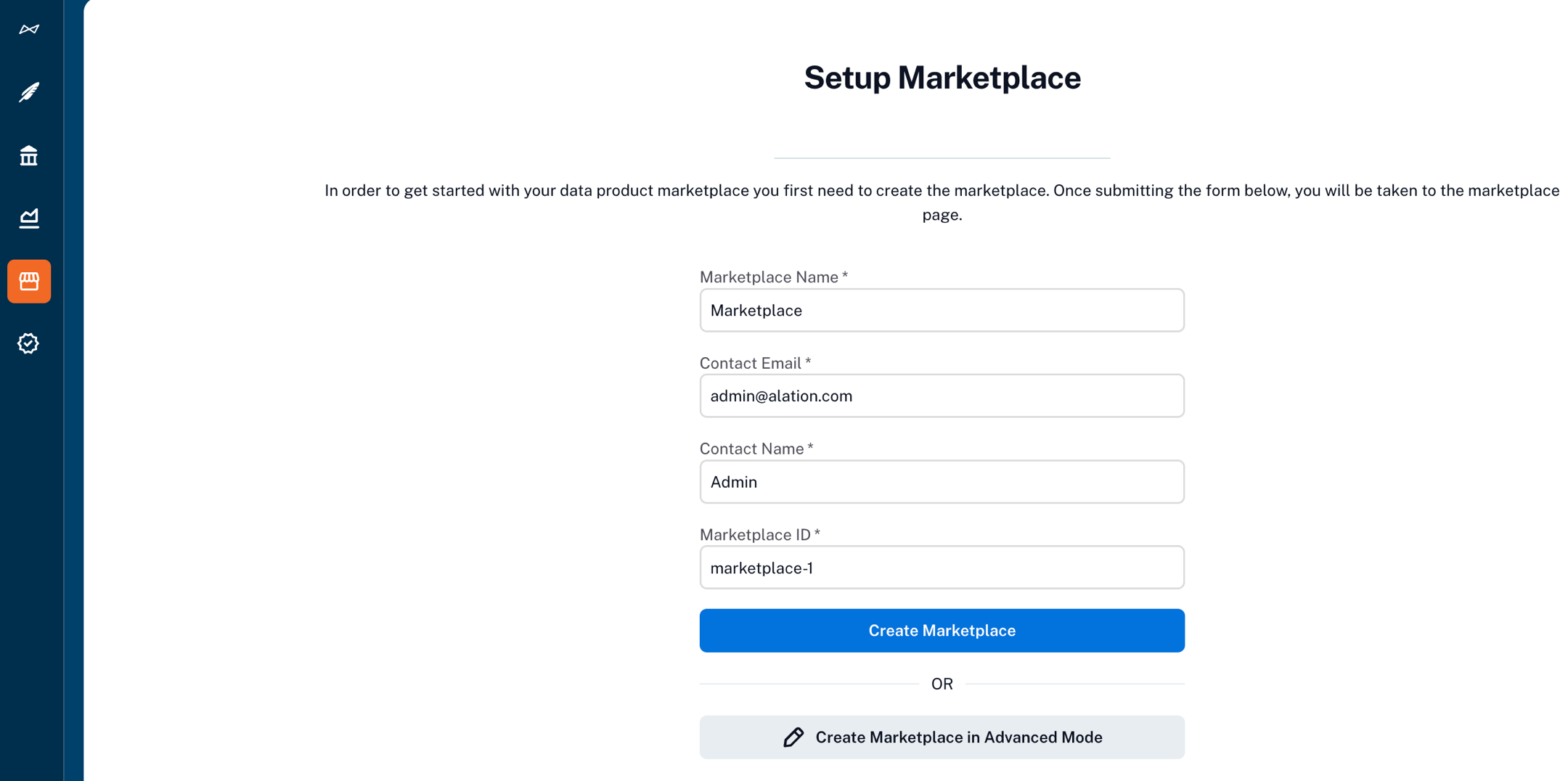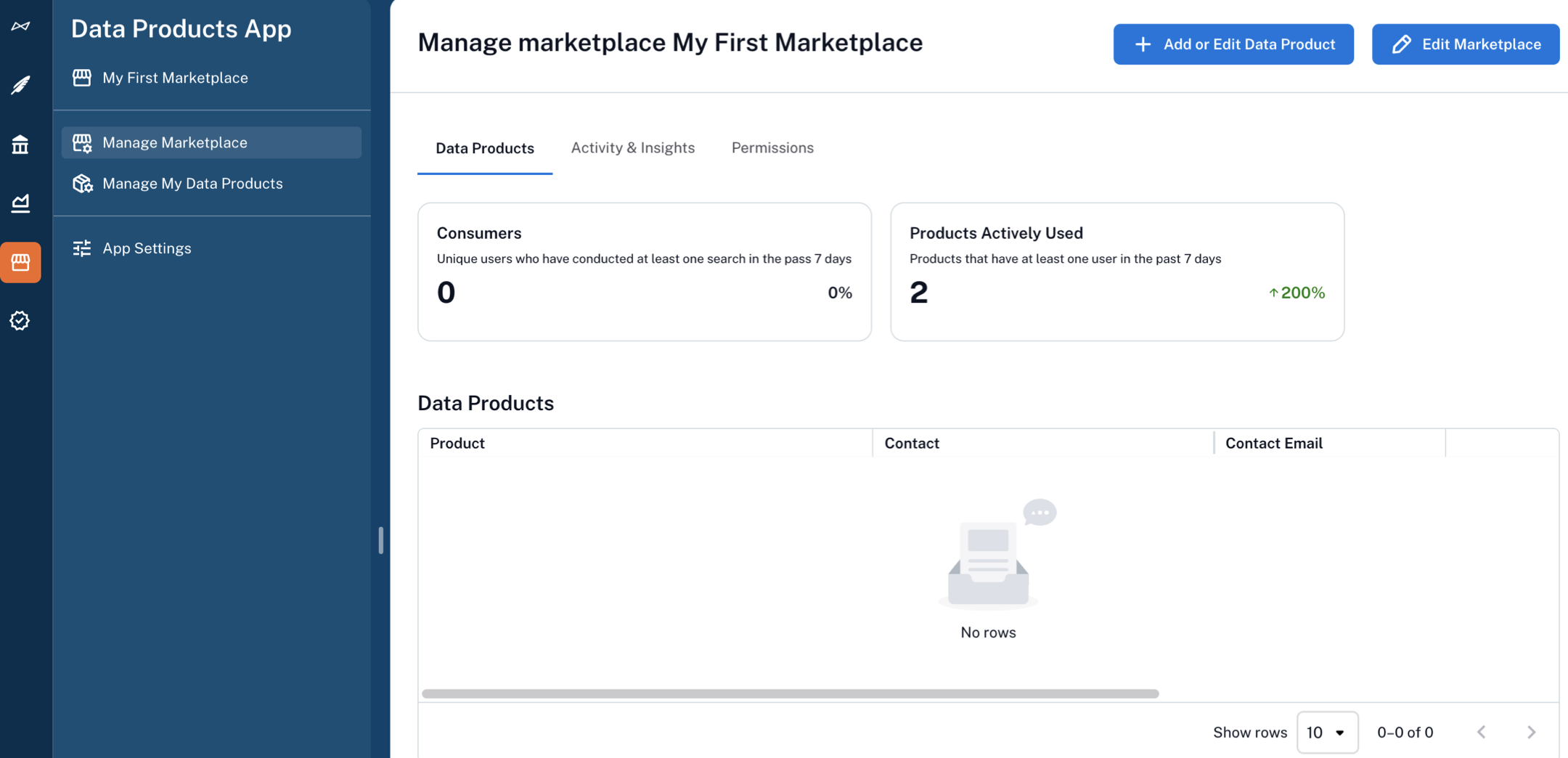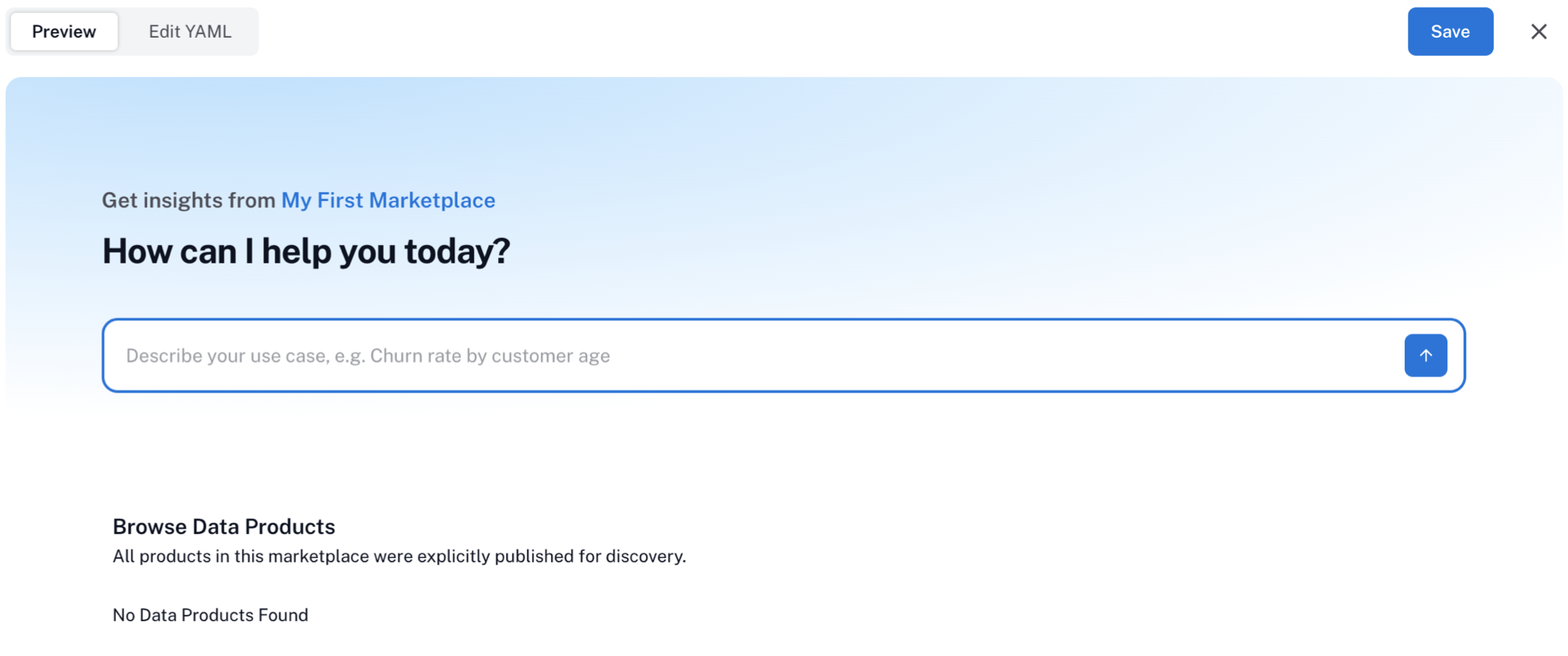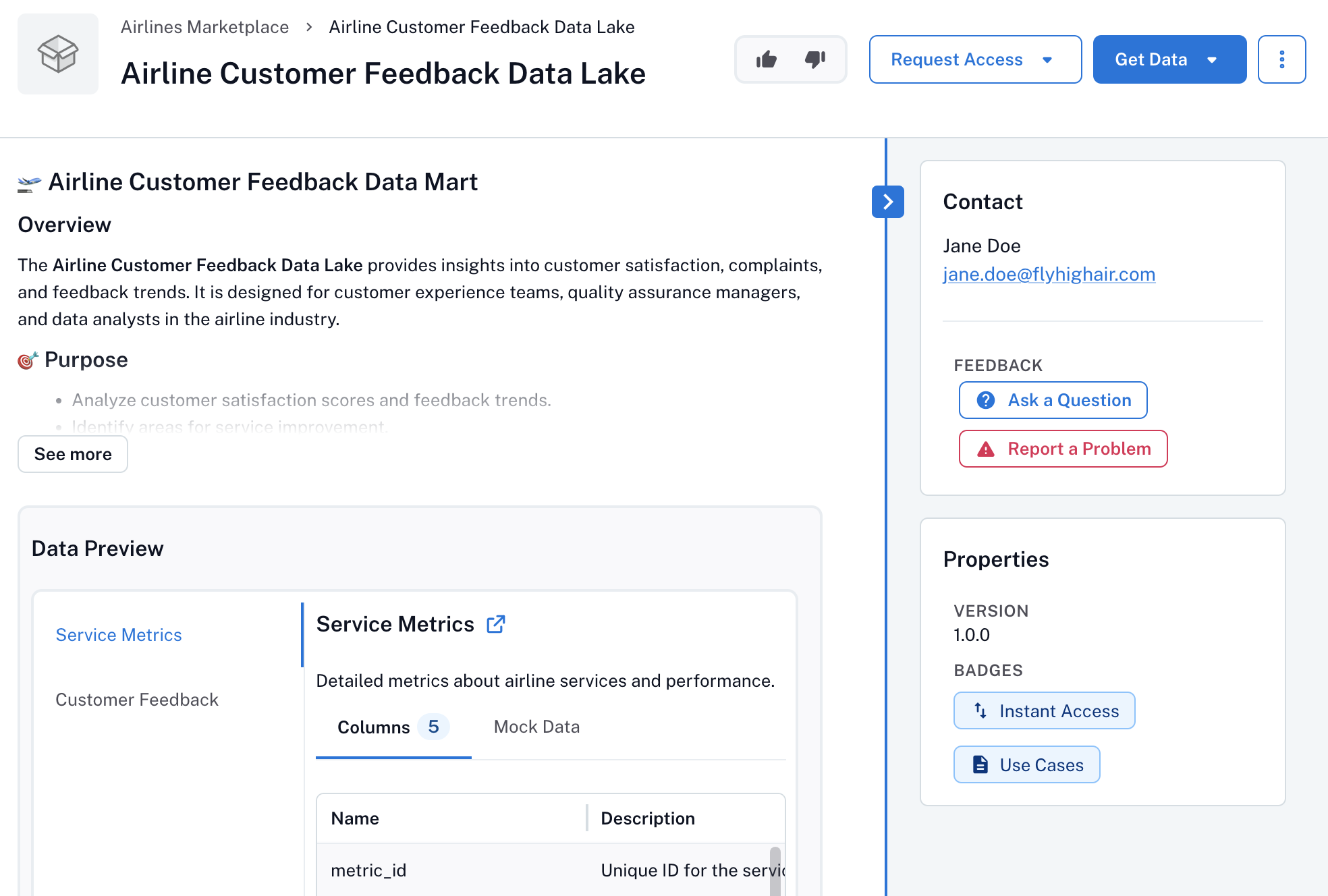Set Up Data Products Marketplace¶
Alation Cloud Service Applies to Alation Cloud Service instances of Alation
Before you set up the Marketplace, make sure the Data Products App has been enabled on your instance:
See Get Started with the Data Products App for information about enabling the App.
See Default Role Assignment in the Data Products App for information about what users can set up the Marketplace.
The Marketplace allows you to:
List data products
Set and govern data product standards
Validate that data products are compliant to standards
Discover available data products
Trust that the data products you find are high quality and well-governed
The Marketplace enforces its own:
Minimum standards (what a data product must include to be listed). This ensures that only useful and trustworthy data products are shown to consumers. If a data product doesn’t meet a minimum standard, it’s not displayed in the search results even if it exists.
Role-based permissions (who can view, list, approve, or remove data products)
In this topic:
Set Up the Marketplace¶
To set up the Marketplace:
In the left-side navigation, click the Data Products App icon. Expand the navigation panel if it’s collapsed. Initially, you see the Set Up Marketplace page.
You have two options:
Create Marketplace: Provide the required properties in the user interface and create a basic Marketplace. To add a more advanced configuration, you’ll edit the Marketplace definition later.
Create Marketplace in Advanced Mode: Set up the Marketplace using advanced configuration by editing its definition in a YAML file. See Configure the Marketplace for details.
Let’s create a basic Marketplace from the user interface. Provide the required information:
Marketplace Name (required): The name is visible to all Marketplace users in the user interface.
Contact Email (required): The email address users can contact with questions about the Marketplace. Ensure the inbox is monitored and ready to receive messages.
Contact Name (required): The name of the Marketplace administrator.
Marketplace ID (required): A unique ID.
Click Create Marketplace.
The initial Marketplace is created, and you are redirected to the new Marketplace catalog page. The left-side navigation now shows all available options for the Data Products App, including the Manage Marketplace menu item. To add more properties, such as governance standards, see Configure the Marketplace.
Configure the Marketplace¶
Only users with the Marketplace Admin role at the Marketplace level can change the definition of the Marketplace. For information on assigning the Marketplace roles, see Configure Access in the Data Product App.
To configure the advanced properties of the Marketplace:
In the left-side navigation, click the Data Products App icon. Expand the navigation panel if it’s collapsed.
Click Manage Marketplace. The Marketplace settings open.
On top right, click Edit Marketplace. The Marketplace editor opens on the Preview tab displaying the current layout of the Marketplace landing page.
Click Edit YAML to open the Marketplace definition.
Note
For reference, you can use the schema specification marketplace_schema.yaml at
https://<base_URL>/static/swagger/specs/data_products/marketplace_schema.yamlon your instance (example:https://mycatalog.com/static/swagger/specs/data_products/marketplace_schema.yaml) when developing the YAML file content.The default definition for the Marketplace looks similar to the example below. You can edit the YAML file directly in the editor and preview the changes in real time. The minimal required properties are un-commented. Additional optional properties are commented out.
schema: https://<base_URL>/static/swagger/specs/data_products/marketplace_schema.yaml marketplace: marketplaceId: marketplace_id_example contactName: Marketplace Owner contactEmail: marketplace.owner@example.com en: name: Marketplace Name # description: | # Optional: Markdown description # This is a description of the marketplace. # shortDescription: Short summary of the marketplace. # Optional: max 200 chars # heroImage: "" # Optional: URL or base64-encoded image # dataProductRequirementsSchema: {} # Optional: custom schema for product requirements # heroBackgroundColor: "#FFFFFF" # Optional: hero section background color (hex) # badges: # Optional: list of badge objects # - {} # minimumStandard: # Optional: list of minimum standard objects # - {}
We’ll walk through editing the YAML file block by block and preview the changes, starting with the required properties.
Leave the
schemaproperty as is. It contains the URL for the schema of the Marketplace object on your instance.Most of the required properties are nested under the
marketplaceproperty, and thenameproperty is under theenproperty:marketplaceId: The Marketplace ID.contactName: Name of the Marketplace admin.contactEmail: Email of the Marketplace admin.name: A name for your Marketplace visible to all Marketplace users.
Toggle on the Preview tab periodically to see how your updated information is displayed on the catalog page.
Uncomment and add optional properties. These optional properties allow you to configure Marketplace standards, a banner (or “hero”) image, long and short descriptions, and badges. Some of these settings control visual appearance, while others influence the features available within data product objects. Find more information on each of these properties below.
description(optional): Markdown-supported content that provides the purpose, business context, and key usage information for the Marketplace.shortDescription(optional): A short summary for the Marketplace.heroImage(optional): An image to use as the background banner for the search bar on the Marketplace landing page. Images must be accessible from within your network. If you don’t provide this property, Alation uses a default image.heroBackgroundColor(optional): A background color for the hero image. If you don’t provide this property, Alation uses a default color.dataProductRequirementsSchema(optional): A custom schema for data product objects.badges(optional) andminimumStandard(optional): See Marketplace Standards and Badges Framework below.
Find an example of a fully defined Marketplace YAML file in Marketplace YAML Example.
Click Save on top right to save the updated Marketplace definition.
Marketplace Standards and Badges Framework¶
The Marketplace standards and badges framework in the Marketplace YAML specification ensures that data products meet essential requirements and enables automatic certifications for products that exceed baseline quality.
Minimum standards (the
minimumStandardproperty) define the base criteria a data product must meet to be listed in the Marketplace.Important
When minimum standards are defined in the Marketplace YAML file, users with permission to edit data products will see a Validate button in the data product editor. This allows them to check whether the data product specification meets the defined Marketplace standards. If the data product does not meet the minimum requirements, the user will receive feedback outlining which conditions must be addressed before the product can be listed.

Badges (the
badgesproperty) are applied automatically to data products that meet predefined criteria. They appear in the Properties panel on the right side of the page, in search results, and on Marketplace tiles, helping users quickly assess the quality of a data product at a glance.
Both minimum standards and badges rely on conditions to determine compliance. You can configure conditions flexibly, either as part of the minimumStandard property or as badges (the badges property), depending on your requirements for the Marketplace.
Conditions¶
Conditions are evaluations based on attributes directly defined in the data product metadata. For example, a Supported badge may require a defined Service Level Agreement (SLA).
Define Conditions for Minimum Standards¶
Within the minimumStandard property, each condition consists of:
type: Currently, only the static type is supported (type: static)
key: Points to the property in the data product’s YAML definition that is being evaluated
check: Defines the the requirement in English or using simple statements likenot null
onFail: The validation response, such aswarnorsuspend
displayName: Describes how the condition is shown in the user interface in the validation feedback
Examples of Static Minimum Standards Conditions¶
Condition: The Product Description Field is Filled Out¶
type: static key: "product.description" check: "not null" onFail: warn displayName: en: "Has a Description"
Condition: The Data Collection Method is Clearly Explained (AI-driven check)¶
type: static key: "product.description" check: "It's possible to understand how the data in this product was collected, including the source and intended use." onFail: warn displayName: en: "Data Origins"
Condition: Custom Property Validation¶
type: static key: "product.x-department" check: "not null" onFail: warn displayName: en: "Department Owned"
Example Marketplace Minimum Standard¶
marketplace:
marketplaceId: example_marketplace
minimumStandard:
- key: "product.description"
type: static
check: "not null"
onFail: warn
displayName:
en: "With description"
- key: "product.contactEmail"
type: static
check: "not null"
onFail: warn
displayName:
en: "With contact email"
Define Badges¶
Badges provide additional validation beyond the minimum standard. They can be defined using an English language check statement similar to the minimum standard.
Each badge consists of:
displayName: The badge label that is visible to users in the user interface
type: Currently, only the static type is supported (type: static)
key: Points to the data product property being evaluated, for example: “product.recordSets”
check: Defines the the requirement in English (like “description has use cases or examples”) or simple statements (likenot null)
icon(optional): Adds an icon to the badge:ImportExport,Description.
Example Marketplace Badges in YAML¶
badges:
- displayName:
en: Data Sample
type: static
key: product.recordSets
check: every record set has a valid sample
- displayName:
en: Use Cases
type: static
key: product.description
check: description has use cases or examples
icon: Description
Marketplace YAML Example¶
marketplace:
marketplaceId: sales_marketplace
contactEmail: allie@alation.com
contactName: Allie
dataProductRequirementsSchema: {}
en:
description: Sales datasets including ARR, new sales, renewals, and churn.
name: Sales Data
shortDescription: Sales data marketplace
heroImage: https://exampleimages.com/uploads/2Ca2L9pXKAgCEex/MarketplaceHeroImage.png
heroBackgroundColor: '#FFFFFF'
badges:
- check: The description of the product describes where the data originates from
displayName:
en: Origin
key: product.description
type: static
icon: Description
minimumStandard:
- check: Product must have a contact email
displayName:
en: Has a contact email
key: product.contactEmail
type: static
- check: Has declared a support response time SLA in the description
displayName:
en: Has a support SLA
key: product.description
type: static
Marketplace YAML Field Reference¶
Your Alation instance includes the Marketplace specification at https://<base_URL>/static/swagger/specs/data_products/marketplace_schema.yaml (substitute <base_URL> with the base URL of your instance).
Here’s a short reference listing the main properties:
Field |
Required |
Description |
|---|---|---|
|
Yes |
Unique ID for the Marketplace |
|
Yes |
Email address for inquiries |
|
Yes |
Name of Marketplace administrator |
|
Yes |
Display name for the Marketplace |
|
No |
Long description of the Marketplace |
|
No |
Short summary (max 200 characters) |
|
No |
PNG or JPG image for branding |
|
No |
Hex color code for background |
|
No |
Required conditions for data product listing |
|
No |
Optional badges for qualifying data products |
Read next:





